Comments / Questions (6)
![]() Loyaux wrote:
Loyaux wrote:
Bonjour, comment trouver les explicationd en français sui sont diso=ponible selon ravelry ?
29.11.2023 - 22:13DROPS Design answered:
Bonjour Mme Loyaux, cliquez sur le menu déroulant sous la photo pour changer la langue et ainsi accéder aux explications en français de ce modèle (mais aussi accéder à tous nos autres modèles en français). Bon crochet!
30.11.2023 - 10:14
![]() Hanna Van Opstal wrote:
Hanna Van Opstal wrote:
Leuk
17.04.2023 - 17:07
![]() LECOMTE wrote:
LECOMTE wrote:
Bonjour, je suis en train de crocheter le modèle Extra 0-946 et je ne comprends pas l'explication du tour 23. Que signifie "Crocheter sur le côté des mailles" ? Pourriez vous m'aider ? Je ne comprends pas comment on arrive à 25 mailles. Je vous remercie de votre réponse. Sylvie Guigo Lecomte
23.06.2021 - 21:47DROPS Design answered:
Bonjour Mme Lecomte, vous avez crocheté le corps en rond sur 19 m au dernier tour puis le cou en rangs sur 12 m seulement. Au tour 23, vous crochetez de nouveau en rond le long des rangs 17 à 22 (= 1 m dans chaque début/fin de rang) + dans les mailles laissées libres du tour 16 (= 7 mailles) + le long de l'autre côté des rangs 17 à 22 (= 1 m dans chaque début/fin de rang) + dans les 6 m du dernier rang, vous devez ainsi avoir 25 m au total. Bon crochet!
24.06.2021 - 08:31
![]() Sewon wrote:
Sewon wrote:
I'm following instruction but it is so hard to understand what does that mean from 23rd to 26th round. As I understood, it should be knitted from left to right, then how can I get 25sts in the end? And should I work on 7sts left 16th round while I'm working on knitting side to side? Or just let those and then do sl st later?
28.06.2020 - 23:30DROPS Design answered:
Dear Mrs Sewon, when you crochet in the round, you always crochet from the right towards the left - you should have 25 stitches on each of the round 23 and 25-26. This video below might help you to crochet the loop pattern. Happy crocheting!
29.06.2020 - 08:56
![]() Micheline wrote:
Micheline wrote:
Ce modèle est très joli et relativement simple une fois qu'on a compris les bouclettes. Merci beaucoup!!!!
17.07.2019 - 14:50
![]() Célié wrote:
Célié wrote:
Ce modele peut il etre tricoté aux aiguilles
23.05.2018 - 09:39DROPS Design answered:
Bonjour Mme Célié, ce modèle peut être probablement adapté pour être tricoté au lieu d'être crocheté, mais nous ne sommes malheureusement pas en mesure de pouvoir ajuster chaque modèle à chaque demande individuelle. Pour toute assistance complémentaire, merci de bien vouloir vous adresser au magasin où vous avez acheté votre laine. Bon tricot!
23.05.2018 - 14:32
Big Billy |
|
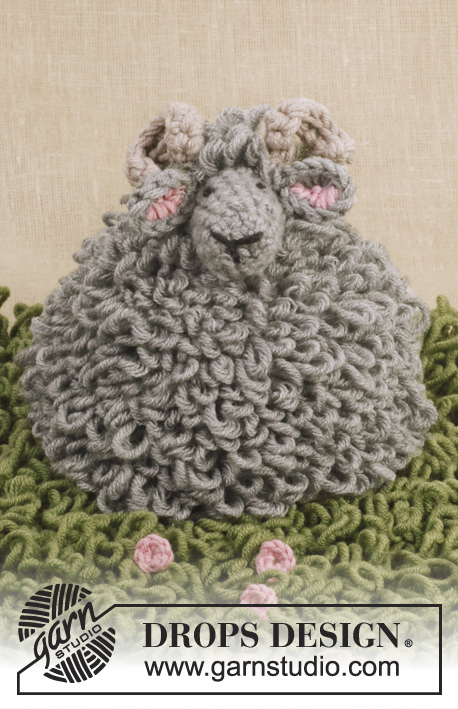 |
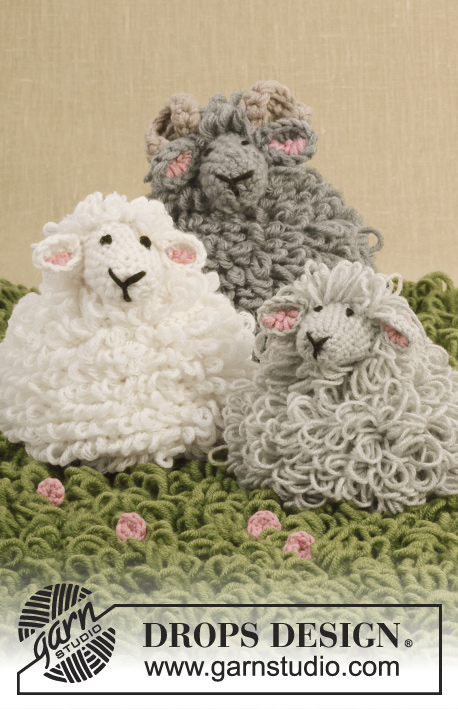 |
Crochet DROPS Ram with loop sts in "Big Merino". DROPS design: Pattern no mb-009
DROPS Extra 0-946 |
|
|
CROCHET INFO: Beg every round with sc and loop sts with 1 ch (this does not replace first st but is extra). Finish with 1 sl st in first sc/loop st from beg of round. DECREASE TIP: Dec 1 sc by working 2 sc tog as follows: * Insert hook in next sc, get yarn *, repeat from *-* one more time, make 1 YO and pull yarn through all 3 sts on hook. LOOP STS: Work as follows: * Pull out some yarn with your left finger, insert hook through st, get the yarn behind the finger and pull it through the st, there are now 2 sts on hook and a loop on your finger. Pull yarn end to make loop the right size. Get yarn end and pull it through both sts on hook the regular way *, repeat from *-*. MAGIC CIRCLE: When piece is worked in the round, start with this technique to avoid holes in the middle (instead of ch-ring): Hold the yarn end and wind the yarn one time around the index finger to make a loop. Hold the loop with left thumb and middle finger, place the yarn over left index finger. Insert hook through the loop, make a YO and pull yarn through loop, ch 1, then work sc around the loop. When the desired no of sc have been reached, pull the yarn end to tighten the loop. ---------------------------------------------------------- RAM: Piece is worked from bottom up, work from inside of piece so that loop sts are on the outside of piece. Work a base to be under the ram, fasten this to the ram when finished. BODY AND HEAD: Ch 50 with gray Big Merino on hook size 5 mm / H/8. Form a ring with 1 sl st in first ch. ROUND 1: READ CROCHET INFO! Work 1 sc in every ch the entire round. ROUND 2: Work LOOP STS - read explanation above, in all sc on round = 50 loop sts. ROUND 3-12: Work as 2nd round. ROUND 13: Work 1 loop st in first st, * skip 1 st, work 1 loop st in next st *, repeat from *-* the entire round = 25 loop sts. ROUND 14: Work loop sts in every loop st on round = 25 loop sts. ROUND 15: * Work 1 loop st in each of the first 3 sts, skip 1 st, work 1 loop st in each of the next 2 sts, skip 1 st *, repeat from *-* 2 more times and finish with 1 loop st in each of the last 4 sts = 19 loop sts. ROUND 16: Work loop sts in every loop st on round = 19 loop sts. Now work back and forth to make neck on ram. ROW 17: (= inside) Work 12 loop sts from where previous round ended, turn piece. ROW 18: (= outside) Work 12 loop sts. Place loops towards you so that loops are on the outside. Or work as before and pull loops on to outside with a crochet hook afterwards. Turn piece. ROW 19: (= inside) Work 12 loop sts, turn piece. ROW 20: (= outside) Work 12 loop sts. Place loops towards you so that loops are on the outside. Or work as before and pull loops on to outside with a crochet hook afterwards. Turn piece. ROW 21: (= inside) Work 12 loop sts, turn piece. ROW 22: (= outside) Work 1 loop st in first st, * skip 1 st, work 1 loop st in next st *, repeat from *-* the entire row = 6 loop sts. Fasten off. Now work in the round to make the head on ram. Continue to work with gray from inside, beg on left side of neck. ROUND 23: * Work loop sts in the side of loop sts worked back and forth on neck (= 6 loop sts) *. Work 1 sl st in each of the loop sts at the front of neck (= 7 sl sts). Repeat from *-* up along the other side of neck and finish with 1 loop st in each of the 6 loop sts from 22ND ROUND = 25 sts around the head. ROUND 24: Work loop sts in all loop sts and sl sts in all sl sts the entire round. ROUND 25-26: Work loop sts in all sts on round = 25 loop sts. Now work the snout with sc as follows: ROUND 27: READ DECREASE TIP! Work 1 sc in each of the next 4 sc, dec 1 sc, work 1 sc in each of the next 7 sc, dec 1 sc, work 1 sc in each of the next 10 sc = 23 sc on round. ROUND 28-30: Work 1 sc in every sc the entire round. ROUND 31: Work 1 sc in each of the next 4 sc, dec 1 sc, work 5 sc, dec 1 sc, work 1 sc in each of the next 10 sc = 21 sc on round. ROUND 32: * Work 1 sc in each of the next 3 sc, dec 1 sc *, repeat from *-* 3 more times, work 1 sc in last sc = 17 sc. ROUND 33: Work 1 sc in every sc the entire round. ROUND 34: * Work 1 sc in each of the next 3 sc, dec 1 sc *, repeat from *-* 2 more times and finish with 1 sc in each of the last 2 sc = 14 sc. ROUND 35: Work sc tog 2 by 2 the entire round = 7 sc. ROUND 36: Work 1 sc in every sc the entire round. Cut the yarn, baste it around the opening and the front on snout and tighten tog. Fasten the strand and embroider eyes, nose and mouth with black. BASE: Worked in the round in a circle with gray on hook size 5 mm / H/8. Loop sts are looser than regular sc and to make the base fit, do not tighten too much when working the base. ROUND 1: Beg by making a MAGIC CIRCLE – see explanation above, with 6 sc in circle. ROUND 2: Work 2 sc in every sc the entire round = 12 sc. ROUND 3: * Work 1 sc in next sc, 2 sc in next sc *, repeat from *-* the entire round = 18 sc. ROUND 4: * Work 1 sc in each of the next 2 sc, then 2 sc in next sc *, repeat from *-* the entire round = 24 sc. ROUND 5: * Work 1 sc in each of the next 3 sc, then 2 sc in next sc *, repeat from *-* the entire round = 30 sc. ROUND 6: * Work 1 sc in each of the next 4 sc, then 2 sc in next sc *, repeat from *-* the entire round = 36 sc. ROUND 7: * Work 1 sc in each of the next 5 sc, then 2 sc in next sc *, repeat from *-* the entire round = 42 sc. ROUND 8: * Work 1 sc in each of the next 6 sc, then 2 sc in next sc *, repeat from *-* the entire round = 48 sc. ROUND 9: Work 1 sc in every sc while AT THE SAME TIME inc 2 sts on round = 50 sc. Fill the ram with some poly stuffing. Place the base under the ram. Work parts tog with sl sts through sc from the base and ch on underside of ram. Fasten off. If the base is too small, you can continue to inc evenly the same way as before after 8TH ROUND, but then you must sew the base on the underside. EAR: Ch 4 on hook size 5 mm / H/8 with gray and form a ring with 1 sl st in first ch. Work 3 ch and 13 dc in ch-ring, finish with 1 sl st in 3rd ch from beg of round. Embroider small sts inside the ear with pink. Fasten strands and fasten ear on the side of head. Work another ear the same way. HORN: Ch 12 with double yarn with some left-over light gray on hook size 5 mm / H/8. Turn, beg to work in 2nd ch from hook, work 1 sc in each of the next 9 ch, finish with 1 sl st in last ch. Cut the yarn and pull it through, fasten the horn right behind the ear. Work another horn the same way. LAWN: Ch 66 on hook size 5 mm / H/8 double strand olive Big Merino, turn piece. Work 1 sc in every ch the entire row. READ LOOP STS! Then work loop sts back and forth. NOTE! Make sure to place the loops towards the same side the entire way. Or work as before and pull loops on to one side with a crochet hook afterwards. Work until piece measures approx. 35 cm / 14" or desired measurements. Fasten off. |
|
Have you finished this pattern?Tag your pictures with #dropspattern or submit them to the #dropsfan gallery. Do you need help with this pattern?You'll find 7 tutorial videos, a Comments/Questions area and more by visiting the pattern on garnstudio.com. © 1982-2025 DROPS Design A/S. We reserve all rights. This document, including all its sub-sections, has copyrights. Read more about what you can do with our patterns at the bottom of each pattern on our site. |
|








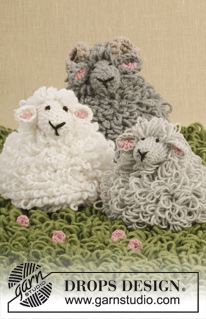




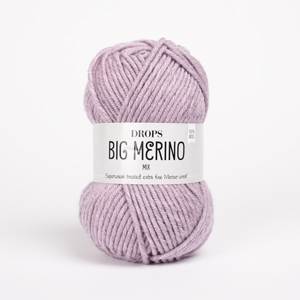
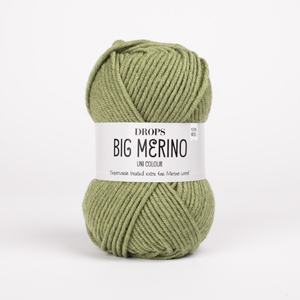



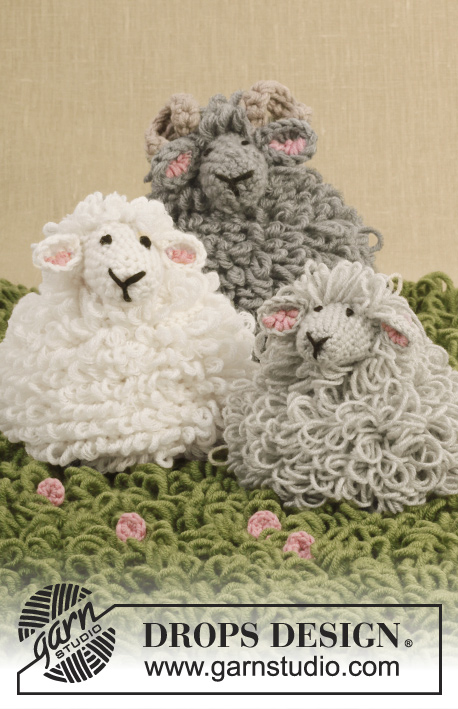





















Post a comment to pattern DROPS Extra 0-946
We would love to hear what you have to say about this pattern!
If you want to leave a question, please make sure you select the correct category in the form below, to speed up the answering process. Required fields are marked *.